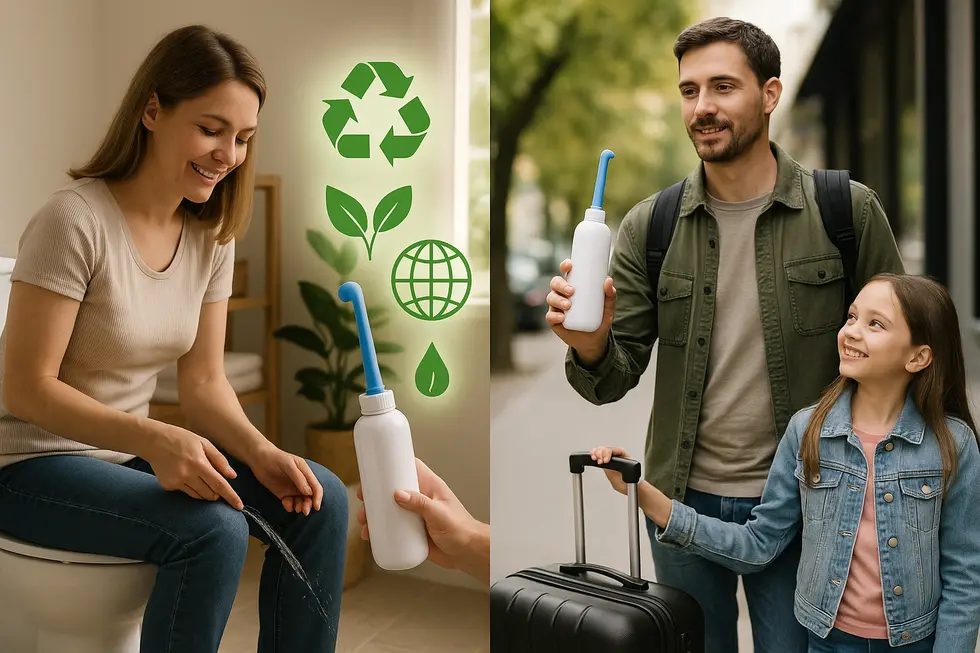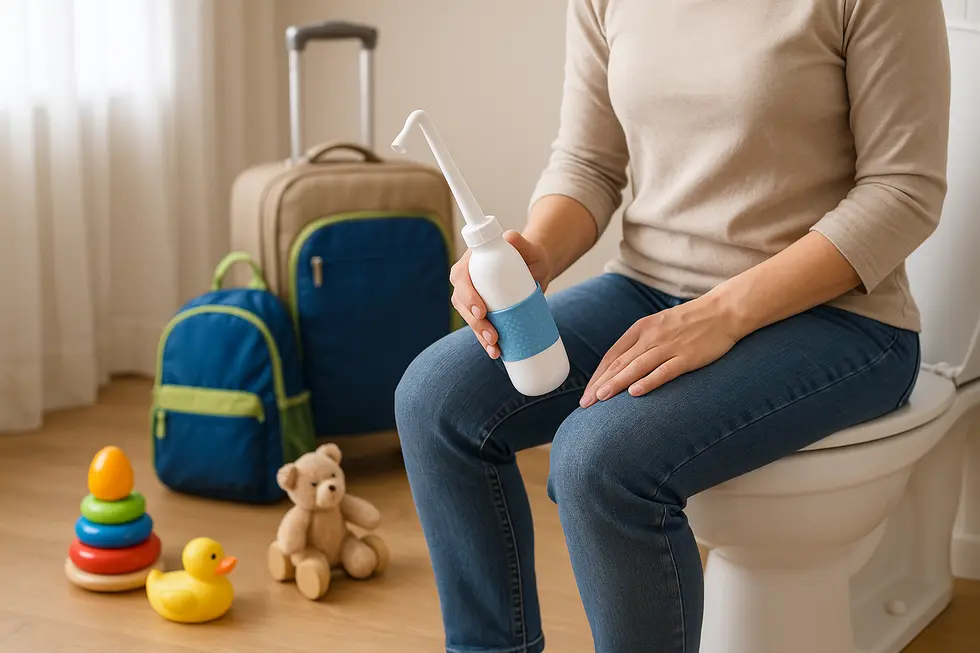Portable Bidet
Exploring Portable Bidet Solutions: Enhancing Hygiene for Families on the Go
Portable bidets offer an innovative and practical solution for enhancing personal hygiene, especially for families on the move or those living in places without permanent bidet installations. A portable bidet for toilet combines the convenience of modern hygiene with the flexibility needed for travel, camping, or small living spaces. These compact devices are designed to provide the cleanliness of a traditional bidet, with the added benefit of portability. This article delves into the technological aspects of portable bidets, explores the growing market trends, and examines the societal and environmental impacts of their use, providing a comprehensive overview for families considering this hygienic upgrade.
Pocket-Sized Hygiene: The Engineering Behind Today’s Portable Bidets

The humble squeeze bottle has evolved into a finely engineered tool that can turn any toilet—whether in a hotel lobby or a trailhead outhouse—into a refreshing water-washer. A portable bidet for toilet offers a hygienic and eco-friendly alternative to toilet paper, ideal for travel or home use. Modern portable bidets start with the reservoir. Flexible, BPA-free silicone is now favored because it collapses like an accordion, shrinking to less than five inches yet expanding to hold roughly half a liter. A firm outer ring prevents the bottle from buckling when squeezed, ensuring a steady stream even when it is only half full.
From that reservoir rises the nozzle, arguably the most critical component. Contemporary designs feature a pop-up stem that hides inside the cap until use, keeping the spray head clean during transport. Internally, tiny channels shape water into a narrow fan that reaches difficult angles while avoiding messy overspray. Some brands add a swivel joint so users can rotate the nozzle instead of twisting their wrist—handy for anyone with arthritis or limited mobility.
Controlling the water pressure is where technology meets simplicity. Manual models rely on ergonomic squeeze zones molded directly into the bottle; thicker silicone below and thinner walls above translate gentle pressure into a firm spray. Battery and USB-rechargeable versions tuck a micro-pump behind the nozzle, offering one to three power settings at the push of a button. These electronic units remain lightweight by using efficient motors borrowed from electric toothbrushes, and most can run a week of trips on a single charge. Whether manual or powered, a portable bidet for toilet offers both convenience and improved hygiene.
Thoughtful touches round out the design language. Extended, gently curved handles help seniors keep their posture, and soft-flow inserts reduce splash for postpartum or post-surgery care. Leak-proof caps with integrated air valves eliminate the vacuum effect, so the bottle does not crumple between squeezes. Many kits also include discreet, quick-dry bags, encouraging travelers to empty and stow the unit immediately after use.
Besides comfort, portability supports sustainability: rinsing with 500 ml of water replaces several meters of toilet paper and leaves no waste to pack out on the trail. Choosing a portable bidet for toilet isn’t just about cleanliness—it’s a step toward a more conscious lifestyle. For more insights into selecting and packing a travel sprayer, see our guide on handheld portable bidets for travel. To explore one collapsible design that embodies these principles, visit the official page for the Brondell Omigo Collapsible Travel Bidet.
From Niche Gadget to Billion-Dollar Boom: Economic Currents Shaping the Portable Bidet Revolution

Barely a decade ago, a portable bidet was a quirky travel accessory. Today it sits at the heart of a market racing from roughly $8.5 billion in 2025 to a forecast-shattering $24 billion by 2032, expanding at nearly 13 percent each year. The figures place these pocket-sized sprayers squarely inside the wider smart-toilet economy, proving that hygiene tech is no longer a luxury—it is an investment trend.
Several forces drive the surge. First comes price. While full smart toilets still command four-figure sums and professional installation, most portable attachments and refillable sprayers cost less than a weekend getaway. Households uncertain about remodeling can test the water—literally—for under $150, finding instant comfort without surrendering floor space or electricity.
Demographics amplify affordability. Aging populations appreciate warm, gentle water that soothes arthritic joints, while Generation Z embraces reduced paper waste as a badge of eco-citizenship. After the pandemic, heightened awareness of surface germs pushed even reluctant North Americans to seek contactless cleanliness, turning curiosity into habitual demand.
Technology adds polish. Bluetooth-enabled seats that record preferred spray strength, voice-activated lids, and UV nozzles once appeared only in flagship Japanese bathrooms; now the same software ecosystems accept data from clip-on or hand-held bidets. Integration with Alexa or Google Home lets users warm a seat or sterilize a nozzle before stepping inside—comfort and reassurance bundled in one sentence.
Regional patterns reveal the future map. Asia-Pacific remains the volume leader, but the strongest growth trajectory is in North America, where retailers dedicate entire end-caps to live demonstrations. E-commerce listings reinforce installation confidence through interactive guides and financing plans, turning a box on the porch into a bathroom upgrade in under ten minutes. For shoppers weighing environmental payoffs, detailed explainers on the benefits of portable bidets close the sale.
This momentum subtly dents toilet-paper demand, yet tourism and population growth keep pulp giants solvent; the story is not elimination but diversification. Investors read the signs: when a simple squeeze bottle evolves into an IoT endpoint cherished by seniors and climate-minded millennials alike, the runway is long. Portable bidets are no longer fringe—they are fluent in the language of modern economics.
From Forests to Households: The Ripple Effects of Choosing a Portable Toilet Bidet

Using a portable bidet may feel like a personal preference, yet its influence echoes far beyond the bathroom door. Every gentle spray replaces several sheets of paper, and that simple swap produces a cascade of environmental wins. Analysts estimate that consistent bidet use can cut toilet-paper demand by more than 90 percent. Fewer felled trees mean intact habitats, lower carbon release from logging, and a dramatic reduction in the 37 gallons of water and harsh chemicals needed to pulp a single roll. Even the wastewater stream benefits; less paper flushes translate to fewer clogs and lighter loads on treatment plants.
Most handheld and battery-assisted models sip resources themselves. Manual squeeze bottles operate on muscle power alone, while USB-rechargeable sprayers draw less energy per week than a phone charger. Because users refill with tap or bottled water already on hand, there is no hidden manufacturing cycle comparable to the perpetual churn of paper mills. The result aligns with global sustainable-living targets and is detailed in this overview of the environmental benefits of portable bidets.
Societal gains track the same path of subtle but meaningful change. Water cleansing is gentler on sensitive skin, reducing irritation, infections, and the medical costs that follow. For seniors, people recovering from surgery, or anyone with limited mobility, a portable bidet for toilet offers a lightweight, dignified solution that restores autonomy in a task that deeply affects quality of life. That independence lessens reliance on caregivers and can delay expensive assisted-living transitions.
Culturally, widespread adoption signals a move toward conscious consumption. Early users often become advocates, normalizing bidets in communities where paper once ruled. Manufacturers respond with sleeker, more inclusive designs—angled nozzles for arthritis sufferers, antimicrobial plastics, and discreet travel cases—further lowering entry barriers. As portable bidet for toilet models dovetail with smart-home chargers and eco-tracking apps, they reinforce the narrative that sustainability and convenience need not clash.
The humble travel bidet therefore stands at the intersection of personal comfort, public health, and planetary stewardship. By turning a routine rinse into a daily act of conservation, it offers one of the simplest ways for individuals to shrink their ecological footprint while elevating quality of life. For a broader look at how paper habits affect forests worldwide, see the Natural Resources Defense Council’s report on tissue production.
Final thoughts
As families seek more hygienic, convenient, and eco-conscious solutions, portable bidets offer a practical option beyond traditional paper use. From advanced technological features to positive market trends and substantial societal benefits, these devices represent a sustainable choice that aligns with modern lifestyle needs. As the demand grows, portable bidets stand to make a significant impact on global habits, hygiene standards, and environmental sustainability, making them a smart investment for families everywhere.
Experience a new standard of clean with PEGABidet—designed for comfort, safety, and independence. Join thousands who trust us to make personal care simple and dignified. Contact us contact@pegabidet.com
About us
PEGABidet is a brand owned by L.A NEXTGEN LLC, based in California. We design intuitive, hygienic, and accessible bathroom solutions that prioritize safety, dignity, and independence. Our mission is to make personal care effortless and empowering for people at every stage of life.

